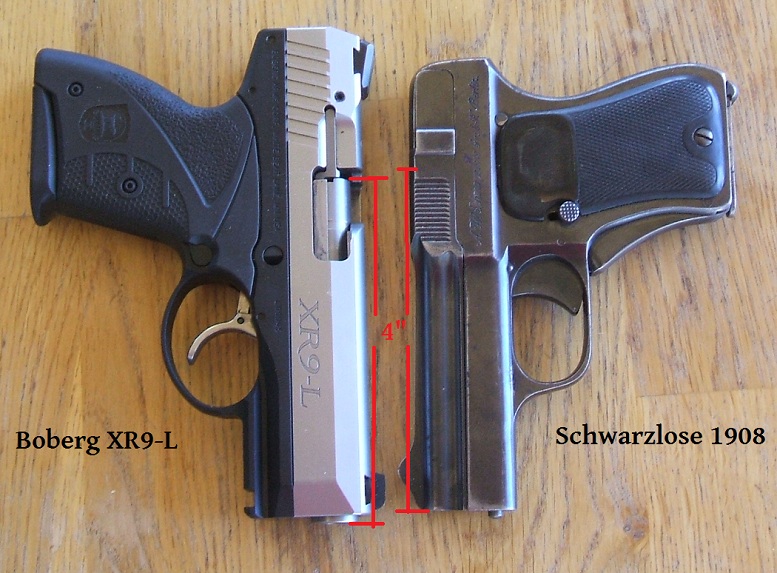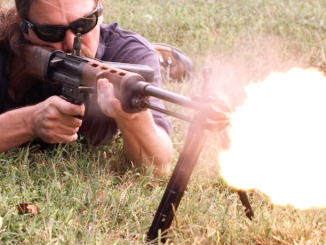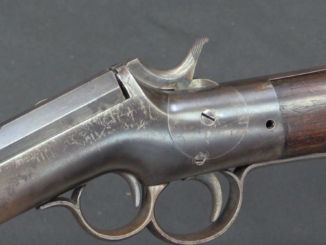When we went to the range to do our video on the Schwarzlose 1908 that you saw yesterday, we didn’t have our slow-motion-capable camera along. I knew it would be great to get some slow footage of that action, so we took it back out with the other camera to rectify the problem. This footage is at 1/4 speed, and things are still moving really fast – the rifle actions we film are downright lethargic by comparison. The last clip is slowed down to about 1/12th speed, and it gives the best view of the workings:
On another subject, have you considered just how few new developments there are in the world of gun design? I know I’ve talked about this before, but it jumped back out at me again on my most recent trip to the range. I had the Schwarzlose 1908 to do the above footage, and I also had along a Boberg XR9-L. The Boberg is a mechanically really neat new pistol that uses a rotating barrel and a feed system that pulls rounds backwards out of the mag. A lot of development went into getting that feed system working right, and all so that the barrel could be a little bit longer than in a conventional design (since the cartridges are pulled backwards and then lifted up to the bore, the barrel can extend back over the magazine).
Ultimately, it’s enough to get a 4″ barrel in a 6″ OAL pistol – not bad. But the goal of maximizing barrel length relative to overall length is not a new one to designers: Schwarzlose used his blow-forward action to the very same end. In fact, back in 1908 he managed a 4″ barrel in a 5.6″ OAL. Hopefully Boberg can take consolation from the fact that their pistol is in 9×19, while the Schwarzlose is in the smaller .32 ACP.

The system used by the Boberg is conceptually pretty similar to the Mars, which dates back to 1898. The Mars wasn’t trying to be a concealable piece, but the loading system is the same basic idea, and the Mars also boasts a long barrel compared to its OAL.
Short of new developments in materials science and the true utilization of electronic fire control systems (which is seriously handicapped by BATF full-auto conversion rules), I think we have pretty much found all the mechanisms that can be used to make a self-loading firearm. All we have left to do (indeed, all we have done for a while now) is recycle them in new combinations and squeeze the last few percentage points of efficiency out of them.




The Boberg is refreshing concept, no doubt – but for price. Actually I like it, but I would not be willing to pay twice for gain of inch in lenght of barrel; it’s just too complicated. Similar and unsual approach is Schwarzlose. It is good to see these “extremities” as to how far the design can go in order to have bulk of what is considered ‘common’ and ‘normal’. FW does good job in obviating it.
Very nice, Ian! I was trying yesterday to catch that motion yesterday.
For handguns themselves, materials are not a significant problem, we actually need the weight to damp the impulse from firing.
Think of an alloy frame .357 mag snubby as an example of a light weight pistol, firing it is about as pleasant as getting caned on your hand at school (when it was still legal for school teachers to physically beat children)
if you are going to have the weight in there, then, you may as well use a moderately priced and free cutting material; SAE 4140, 4340, 416 stainless etc.
The pressure and powder capacity of rounds for small guns for defensive use is probably as high now as you’d want to take it – If you have to use a gun for self defense, chances are you won’t have ear protection on, and the blast from a .357 mag out of a snubby is almost as disorientating and damaging to the firer, as having both your ears slapped.
Brass or steel cases serve perfectly well to seal the breech with the case mouth and to contain the gas pressure with the case head. Also, chambering a new pistol for a unique round is taking a double risk in market which has historically seen far more guns forgotten than it has seen remembered.
One of the thoughts which attracted me to blow forward, is the idea that the main moving part – the barrel, is making use of a part which the gun has already, to perform the additional functions of the repeating mechanism
the barrel usually already has sufficeint weight to be providing a delay in opening the breech, as it is propelled by the much lesser force of bore friction rather than pressure in the case head.
The slow motion vid of the Schwarzlose, shows that even at the black powder like operating pressures of .32ACP, that bore friction is still pretty strong, I don’t think that the floating chamber idea offered by Lichtman in his patent for the Semmerling LM4 in .45 ACP (black powder pressure levels again), would be necessary. after seeing the vid, I think a delay mechanism might be needed.
cont
Another feature of the Schwarzlose (and the very similler sized Semmerling in .45 http://www.amderringer.com/lms.html ) compared to the Boberg or any of the present day conventional semi autos is the very low bore axis – and that is with a 100 year old pistol
There is no fear of having furrows ploughed through the web of your hand by a blow forward’s slide, so the web of the hand can be very high up in relation to the bore axis.
One of the benefits claimed in reviews of the Ghissoni designed Chiappa Rhino revolver, is very little torque and very comfortable recoil for a gun of its chambering and weight – thanks to the low bore axis and well designed grip.
I wonder, if with a bit of tinkering:
the bore of a blow forward could be lowered even further, perhaps by using the bell crank recoil spring system of the PB silenced Makarov and placing the recoil springs and buffer in the grip
Keeping the weight of the barrel / slide to the minimum needed to achieve safe reliable cycling
and carefully designing a more comfortable grip
– a blow forward could be made at least as comfortable as a simillar weight revolver in the same chambering?
Link back to Max Popenker’s piece on the PB silenced Makarov
https://www.forgottenweapons.com/russian-9mm-pb-silenced-pistol/
Thank you for a good overview of that pistol.
I have been fascinated by the Schwarzlose 1908 for a very long time, and spend far more time searching for videos of it in action than I care to admit.
Now all of the sudden they are popping up all over the internet.
Another way of viewing the physics behind a Blow-Forward operation is to think of the friction between the bullet and the barrel being what is pulling the barrel forward.
In your other video you mention that the indent in the frame, and the bump on the sear bar is a safety feature. I would think that it is more designed for the purpose of being a disconnector, rather than a safety device. When the barrel moves forward it pushes the searbar upward, so that when it move back back the notch on the front of the searbar will rest on top of the trigger bar and not fall down until the trigger is released.
I like the comparison between it and the Boberg. It puts things in perspective.
On a side note: I am wondering what camera you are using for high speed filming?
At the risk of sounding like an advertiser, I bought a Casio Exilim ZR 200 a good while ago, and have been filming just about anything I can get close to.
It is a quite affordable (I think it was just above $200) pocket sized camera capable of filming 1000 fps (at 224×64) (and lower framerates at higher resolutions)
The camera was cheap enough that I don’t mind putting it in harms way for a good shot, and I have found that it can take quite a lot of abuse (been near the muzzle of a 84mm Carl-Gustav, been in the direct muzzle blast of various rifles, and it has been hit by half a a brick and various other debris)
The quality doesn’t come anywhere near a professional high-speed camera, but for it’s size and price I am extremely impressed by the Casio.
Again, thank you for a good set of videos.
Years ago a friend who knew semi-auto’s inside and out said the same thing. Usually by commenting on how a turn of the century pistol had ‘infringed’ on the latest great idea on a new pistol. Or that the P-18 would have made a great cavalry pistol.
He was fantastic. Could look at a box of parts at a gun show and pick out grips, extractors and other parts for the most obscure pistols.
Schwarzlose 08 is really a very unique design. Thanks for detailed video.
It seems that production model differs from the gun describted in two patents
granted for Scwarzlose as;
– Recoil spring location; under the barrel on production and around the barrel
on patents,
– Trigger axis pin on top of production and none on patent, and production
trigger should get to be of at least two pieces to create a backward motion as
contrast of being one piece in the patents.
– Disconnector is a seperate part on the sear bar on production while being of one
piece as working kicking off the squezzed trigger finger on patents.
Regarding to the working principle, blow forward bases upon, movably plugged gas
piston principle. Barrel motion might be obtained even no projeçtile contact is
present which is impossible, by compressed gas friction which might not cycle the
action properly.
Some other interesting points of production gun are,
– Hammer is cocked by recoil spring force, just like pistols of today like Glock,
– Every manual actuating of barrel cocks and recocks the hammer, and in hammer
cocked position, this motion should be made easier,
– Tip of firing pin acts as an ejector just like FN 1910/22, but there may be
another part unnoticed for this task as being on Mauser 1914 pistol.
Thanks again for this wonderful post. Looking forward some other popular pistols
like Savage 06 and Remington M51.